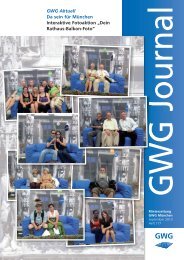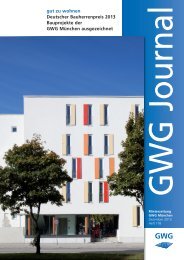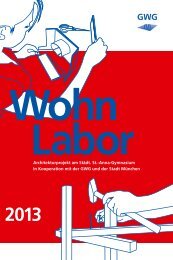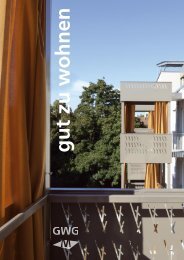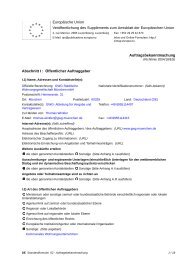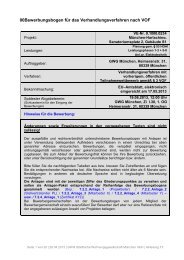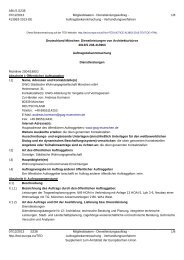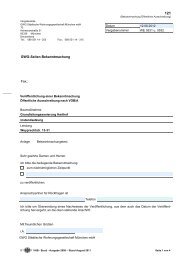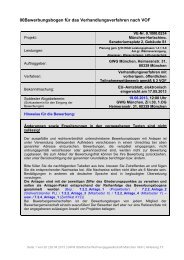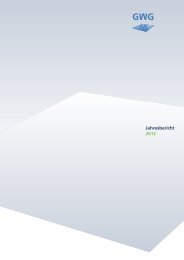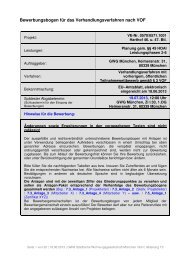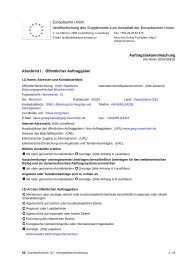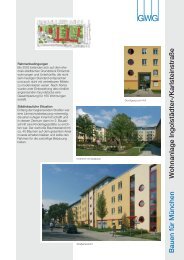New build - GWG München
New build - GWG München
New build - GWG München
You also want an ePaper? Increase the reach of your titles
YUMPU automatically turns print PDFs into web optimized ePapers that Google loves.
of small businesses and residences is<br />
fading away. Old workshops are being<br />
converted into luxury loft apartments,<br />
while dirt, dust and labour are disappearing<br />
from the Au, as more and more<br />
tradespeople move elsewhere. But one<br />
thing has remained constant: the attraction<br />
of the Paulaner monks’ "Starkbieranstich”<br />
Strong Beer Festival on the<br />
Nockherberg above the ice-age slope.<br />
However, over the last couple of<br />
decades, the downside of a prosperous<br />
city like Munich has started to become<br />
apparent. Luxury renovations and gentrification<br />
have begun impacting on the<br />
neighbourhood beyond the Deutsches<br />
Museum. Badly hit during the Second<br />
World War, little more than 20% of the<br />
housing in the Au is older than 100<br />
years. The primary aim of the <strong>build</strong>ings<br />
erected just after the war was to create<br />
as much housing as possible, as quickly<br />
and cheaply as possible. Cramped apartments<br />
with oil stoves in the rooms were<br />
the rule rather than the exception. The<br />
main requirement: For people to have a<br />
roof over their heads.<br />
But expectations rise. What may have<br />
been tolerable yesterday is no longer accepted<br />
today. It is now virtually impossible<br />
to rent out apartments with neither<br />
central heating nor a bathroom. As the<br />
owner of a large number of properties,<br />
<strong>GWG</strong> <strong>München</strong> reacted to this situation<br />
and gradually improved its properties.<br />
Today, the results of these careful modernisation<br />
measures are a wonder to<br />
behold: green oases, residential ensembles<br />
whose quiet courtyards and old<br />
trees are the perfect place to enjoy the<br />
day as it draws to a close. The old and<br />
the new infuse each other, not only<br />
because <strong>GWG</strong> <strong>München</strong> made every<br />
effort it could to preserve the longevolved<br />
social structure.<br />
The Au is located to the right of the Isar, stretching from the<br />
Ludwigsbrücke bridge in the north to the Wittelsbacherbrücke<br />
bridge in the south. Below the slope of the Isar’s high bank is<br />
the Lower Au (Untere Au), while the Upper Au (Obere Au) lies<br />
above the slope.<br />
The Au is bordered to the north by the Rosenheimer Strasse,<br />
Hochstrasse, Rablstrasse und Balanstrasse. It is adjoined here<br />
by the neighbourhood of Haidhausen, which is part of the<br />
same district.<br />
The railway lines to the east form the border to Obergiesing,<br />
and the Humboldstrasse in the south separates the Au from<br />
Untergiesing.<br />
Statistics Office of the State Capital of Munich<br />
The following data refers to District 5, Au-Haidhausen, in its<br />
entirety, and is not restricted to the Au neighbourhood (correct<br />
as of 2008, data given without guarantee):<br />
Area<br />
Au-Haidhausen has an area of 422 hectares.<br />
Population<br />
– There are 55,288 people living in District 5.<br />
– The proportion of senior citizens over the age of 65 is<br />
approx. 14%.<br />
– The proportion of children and young people up to the age<br />
of 18 is 10%.<br />
103



